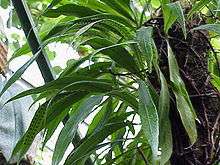Polypodium
| Polypodium | |
|---|---|
.jpg) | |
| Common Polypody, Polypodium vulgare | |
| Scientific classification | |
| Kingdom: | Plantae |
| Division: | Pteridophyta |
| Class: | Polypodiopsida / Pteridopsida (disputed) |
| Order: | Polypodiales |
| (unranked): | Eupolypods I |
| Family: | Polypodiaceae |
| Genus: | Polypodium L. |
| Species | |
|
75–100, see text | |
Polypodium is a genus of 75–100 species of true ferns, widely distributed throughout the world, with the highest species diversity in the tropics. The name is derived from Ancient Greek poly (πολύ) "many" + podion (πόδιον) "little foot", on account of the foot-like appearance of the rhizome and its branches. They are commonly called polypody[1] or rockcap fern, but for many species unique vernacular names exist.
They are terrestrial or epiphytic ferns, with a creeping, densely hairy or scaly rhizome bearing fronds at intervals along its length. The species differ in size and general appearance and in the character of the fronds, which are evergreen, persisting for 1-2 years, pinnate or pinnatifid (rarely simple entire), and from 10-80 cm or more long. The sori or groups of spore-cases (sporangia) are borne on the back of the frond; they are globose and naked, not covered with a membrane (indusium).
Polypodies have some use in herbalism, but are today most important in horticulture where several species, hybrids, and their cultivars like Polypodium 'Green Wave' are commonly used as ornamental plants for shady locations. Polypodium have a bitter-sweet taste and are among the rather few ferns that are used in cooking; in this case as a spice e.g. for nougat.
Selected species
Several of the species form hybrids with other species in the genus; these may often be distinguished by being sterile, with very small "blind" sori.



- Polypodium abitaguae
- Polypodium alfredii
- Polypodium amorphum Suksdorf – irregular polypody
- Polypodium appalachianum Haufler & Windham – Appalachian rockcap fern
- Polypodium argyrolepis
- Polypodium australe Fée
- Polypodium asterolepis Baker
- Polypodium billardieri
- Polypodium californicum Kaulf.
- Polypodium calirhiza – nested polypody, habit polypody
- Polypodium cambricum L. (= P. australe Fée) – southern polypody
- Polypodium chionolepis
- Polypodium decumanum – Calaguala fern
- Polypodium excavatum Roxb.
- Polypodium exiguum – hug-me-tight
- Polypodium feei (Bory) Mett.
- Polypodium × font-queri (P. cambricum × P. vulgare)
- Polypodium formosanum Baker - grub fern
- Polypodium furfuraceum Schltdl. & Cham.
- Polypodium glycyrrhiza D.C.Eaton – licorice fern
- Polypodium hesperium Maxon – western polypody
- Polypodium incanum
- Polypodium × incognitum
- Polypodium interjectum Shivas – intermediate polypody
- Polypodium latissimum
- Polypodium lepidopteris (Langsd. & Fisch.) Kunze
- Polypodium macaronesicum Bobrov
- Polypodium × mantoniae (P. interjectum × P. vulgare)
- Polypodium mindense
- Polypodium mixtum
- Polypodium nigrescens Blume
- Polypodium nipponicum – aonekazura' (Japanese)
- Polypodium percussum
- Polypodium phymatodes L.
- Polypodium piligerum
- Polypodium punctatum Thunb. ex Murray
- Polypodium pustulatum
- Polypodium pycnocarpum C.Chr.
- Polypodium quitense
- Polypodium rimbachii
- Polypodium × rothmaleri (P. cambricum × P. interjectum)
- Polypodium saximontanum Windham
- Polypodium scouleri Hooker & Greville – coast polypody
- Polypodium scutulatum
- Polypodium segregatum
- Polypodium × shivasiae Rothm. (P. cambricum × P. interjectum)
- Polypodium sibiricum Sipliv. – Siberian polypody
- Polypodium triseriale Swartz
- Polypodium virginianum L. – rock polypody
- Polypodium vulgare – common polypody
- Polypodium xalapense
A number of species formerly included in the genus have recently been transferred to other genera, including Campyloneurum, Cyathea, Drynaria, Microgramma, Nephrolepis, Neurodium, Pecluma, Phlebodium, and Pleopeltis.
See also
References
- Haufler, Christopher H.; Windham, Michael D.; Lang, Frank A. & Whitmore, S. A. (1993): 2. Polypodium Linnaeus. In: Flora of North America North of Mexico, Vol. 2 (Pteridophytes and Gymnosperms): 315-323. ISBN 0-19-508242-7
- Hyde, H. A.; Wade, A. E. & Harrison, S. G. (1978): Welsh Ferns. National Museum of Wales.
- Royal Botanic Garden Edinburgh (RBGE) (2007): Digital Flora Europaea: Polypodium species list. Retrieved 2007-NOV-26.
- United States Department of Agriculture (2007): Germplasm Resources Information Network - Polypodium. Retrieved 2007-NOV-26.
External links
-
 "Polypodium". Encyclopædia Britannica (11th ed.). 1911.
"Polypodium". Encyclopædia Britannica (11th ed.). 1911.